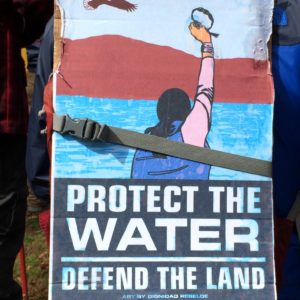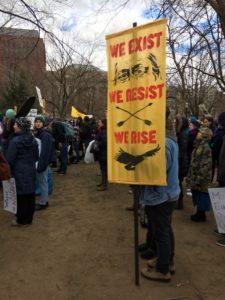The Standing Rock protest camps are long gone, hauled away in dumpsters. Construction of the pipeline itself is roaring ahead, with some industry figures even hinting at an early opening. But for the attendees of the Native Nations March in Washington, D.C. on Friday, the effects of the protest lived on. As they put it, they were “standing strong,” for tribal sovereignty, environmental issues, and a shift in the way the federal government consults with the tribes.
The day’s events highlighted the impact of the DAPL protest camps in bringing native rights issues to national attention. Despite morning sleet, hundreds of protesters marched through the streets of Washington with drums and flags from the Army Corps of Engineers headquarters to Lafayette Park. The Native Nations March stopped in front of the White House for a rally including speeches and performances by Native American dancers and musicians.
For those who gathered, Standing Rock was not a failure, but a call to action.
“Tribal Nations and grassroots Indigenous communities rising to the call set forth by the Standing Rock Sioux Tribe to defend our inherent rights to protect Unci Maka and our water: Mni Wiconi,” said the event’s organizers.
In Lafayette Park, speakers urged the crowd into chants of “We exist, we resist,” and the catchphrase of the Standing Rock protest, “Water is life.” The goals of the protest were less well-defined, though.
Over time, the DAPL protests have shifted. When the first tents arrived in Cannon Ball, N.D., protesters sought to move the Missouri River DAPL crossing to protect the Standing Rock Reservation against potential contamination. Over time, the camp came to include more and more environmental activists, who wanted to stop fossil fuel production altogether. As winter approached and the camps began to disperse, protesters left North Dakota to a variety of other protests combining environmental concerns with native rights. This is the spirit that lived on at the Native Nations March.
The Native Nations March featured speeches from representatives of all of these groups.
Faith Spotted Eagle, a leader at Standing Rock, spoke of her concerns for the future of the river.
“We are in danger, possibly by 2040, of the Missouri River drying up,” she said. It fell to the protesters and their allies to work to stop this. “We have work to do, but Cannon Ball and Standing Rock told us it must be founded on culture.”
Other speakers pushed for a shift in how the U.S. government interacts with native tribes. Rather than just consultation, as was the case with the DAPL project, they want tribal consent to be a necessity. One of the goals of the march was to pressure the Trump administration to treat tribal governments as it would a foreign nation.
Supreme Court cases since the early 20th century have held that Indian tribes have sovereignty in their reservations over matters of taxation and criminal justice. However, it does not treat them as fully independent nations and says that they are still subject to laws passed by Congress.
In addition to the push for increased tribal rights, other speakers addressed environmental concerns about fossil fuel use. Periodically chants of “No more oil, keep it in the soil!” ran through the crowd, with women responding with ululations of agreement.

LaDonna Brave Bull Allard of the Standing Rock tribe addresses protesters. (InsideSources/Erin Mundahl)
At times, the speeches gathered together a collection of environmentalist, anti-corporatist, and native imagery without fully explaining the connections between them. When Congresswoman Tulsi Gabbard addressed the crowd, her speech worked to tie the protest movement back to the American founding.
“We must always remember that the laws of our nation are built on the foundations of the natural law, a law that cannot be debated or overturned, laws that are not subject to the manipulations of special interest or corporations,” she said.
She called on those present to “take a stand for future generations.”
For some in attendance, the Native Nations March was as much about showing the Trump administration that minority rights need protection as it was about the pipeline itself. Although Trump was not explicitly mentioned by many speakers and signs, protesters certainly had him in mind, particularly when chants of “Love trumps hate” occasionally broke out.
In contrast to the Cannon Ball, N.D. protest camps, police presence at the Native Nations March was minimal.
Instead, the music and shouting continued. As the protesters say, Standing Rock is gone, but its spirit lives on.


